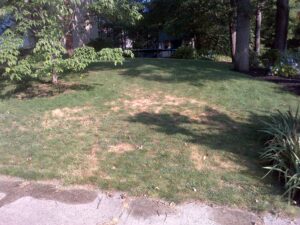Main Content

According to Merriam-Webster, dog days is the period between early July and early September when the hot sultry weather of summer usually occurs in the northern hemisphere; a period of stagnation or inactivity.
The dog is actually the Dog Star – also called Sirius – which rises simultaneously with the sun during the hottest days of summer in the northern hemisphere. Plutarch (Greek writer, 46-120 AD) referred to the hot days of summer as hēmerai kynades (literally, “dog days”); the Latin translation dies caniculares is the source of our English phrase. But I digress…
You most likely have noticed that cool-season grasses have recently entered a period of stagnation or inactivity (dog days) and, in some cases, are spent. The hot summer days have steadily increased soil temperatures to the point that the soil is now warmer than air temperature for much of the daylight hours and all of the night. During the last 10 days at Hort Farm No. 2, soil temperature at 3-inches has oscillated between 76 and 90 °F and at 2-inches 78 and 92 °F. These soil temperatures are well above the optimum temperatures for root growth and clearly explain why cool-season grasses are lethargic at this time.
What to do? Be patient and do not “push” the grass. This is not the time of year to stress out turf – the grass has very little resiliency and will not tolerate much abuse or recovery quickly. I recently witnessed utility vehicle traffic on subtly drought stressed turf during the hottest part of the day result in classic tire-track damage. Root systems of cool-season grasses are weakest and shallowest at this time of year. Thus, localized drought stress can develop rapidly – within a couple hot, sunny days – during the dog days.
These cultural practices can be helpful in getting high value turf to survive dog days. Once the turf has drained after drenching thunderstorms (2-3 days), program daily, very-light (50-65% of reference ET), deficit irrigation using a rainhold setting (such as 0.2-inch rain) to stop irrigation from adding to over-wetting from storms. Deficit irrigation assures that thunderstorms will be the reason for excess wetness, not the irrigation schedule. This irrigation plan should encourage the turf the dry without over-drying between irrigations (or thunderstorms). If excess drying does occur with this irrigation plan, it probably will start in highly localized (small) areas, which can be effectively managed with well-timed syringing to re-hydrate dry leaves and prevent crispy thatch during the heat of the day. Crispy thatch means that surface adventitious roots either are or will soon be crispy as well. Moist to dry thatch is good, whereas crispy and crunchy thatch in the heat is bad. Weekly, low-rate fertilization (N and possibly P, K and micronutrients) is crucial on sand-topdressed and sand-based rootzones commonly found on golf course putting greens and some sports turfs. These rootzones have very little mineralization capacity to supply essential nutrients during dog days. Weekly low-rate fertilization provides a steady, consistent slow-growth and avoids the “surge-crash” cycle of growth that results from less-frequent and higher application rates. Typically, low-rate N is no more than a 0.1-lbs. per 1,000-sq. ft.